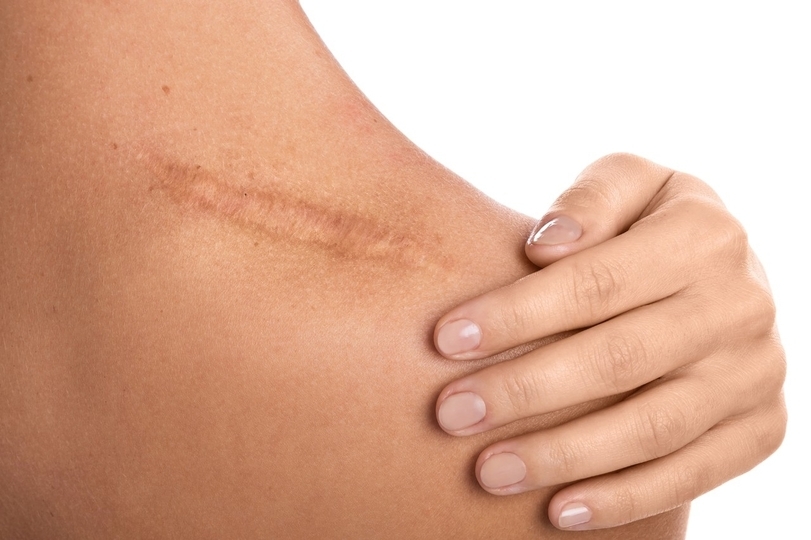Removal of scars after burns and restoration of appearance
Many people are left with extensive scars after burns heal, which look unsightly and cause discomfort during movement. Modern plastic surgery offers a range of treatments for burn scars of varying severity on the body or face.
Features of burn scars
Burn scars are considered one of the most difficult to treat. Hot surfaces, open flames, various chemicals, exposure to electric current, and explosive injuries of varying severity are just some of the things that can cause skin burns that leave scars. First-degree burns usually heal without scarring, while second- and third-degree burns leave scars of varying sizes.
Burns cause local skin cell death. The skin then produces collagen, a protein necessary for regeneration. As the skin heals, an area of altered skin structure called a scar forms. While some small scars fade over time (especially in young patients), most burn scars are permanent.
Burn scars usually cover a large area of the face or body, significantly affecting a person's appearance, which can worsen their psychological health and complicate their adaptation to society.
Treatment depends on the size and severity of the burn. In some cases, a course of cosmetic procedures will suffice, while in others, surgical intervention is necessary.
Symptoms that characterize scars after burns:
- Change in the color of the affected skin (discoloration, redness, etc.) compared to healthy skin.
- Changes in relief and texture. Scars may be completely smooth or protrude above the surface of healthy skin, be very soft or hard to the touch, etc.
- Pain and itching. Some scars, especially in areas where the skin is stretched, can cause significant discomfort to the patient during physical activity.
Why do scars form from burns?
Scars form when the dermal layer of the skin is damaged. The body produces a protein known as collagen to help heal the injured skin.

Collagen fibers are organized evenly in healthy skin, but once a scar forms, they have to reform in a chaotic pattern. This gives the new skin a different texture and a distinctive appearance.
Burns are classified into three types depending on the damage they cause to the skin.
- First-degree burns are those that damage the upper layer of the skin and the epidermis and cause pain and redness. They usually heal within 6–10 days without leaving scars.
- Second-degree burns affect both the dermis and the epidermis. The patient experiences moderate pain, and blisters form on the affected area. These burns heal in 2–4 weeks and usually leave scars.
- Third-degree burns are more serious: they cause damage to the dermis and epidermis, as well as bones, tendons, and nerve endings. Such injuries take a very long time to heal and leave irreversible scars.
Types of scars after burns and methods of treatment
Scars after second- and third-degree burns are divided into several main types.
- Contracture scars occur as a result of wound healing after re-epithelialization. They are usually large and quite dense, preventing the skin from stretching normally and causing difficulties during movement. The skin in the area of a contracture scar also tends to become dehydrated, which in turn causes itching and flaking.
Surgical intervention helps to restore damaged tissue and improve the patient's appearance using skin flaps and skin grafts. A plastic surgeon may also use a special technique in which the degree of scar contracture is reduced by making incisions. He or she may also try to change the position of the scar so that its edges resemble natural skin folds and wrinkles.
- Hypertrophic scars are characterized by excessive collagen formation, which leads to a raised scar. These scars often contain blood vessels and nerves and frequently appear after thermal or physical trauma affecting the deep layers of the skin. The body produces new collagen fibers at a rate that balances collagen degradation during the healing of a typical wound.
Hypertrophic scars usually do not extend beyond the original perimeter of the wound, but remain thickened for up to 6 months. The appearance or severity of hypertrophic scars can affect a patient's appearance or restrict movement if located close to joints. There are several treatment options for hypertrophic scars. These include corticosteroid injections, laser treatment of scars, cryotherapy, and modern plastic surgery techniques.
- Keloid scars consist of different types of collagen and vary in color from red to dark brown. These scars can cause itching, discomfort, and changes in texture, so in severe cases, they may require surgical removal. The first signs of keloid formation become noticeable 3-12 months after the injury and continue to grow slowly over several years. For small keloid scars, you can consult a qualified dermatologist who will prescribe corticosteroids, laser therapy, or cryotherapy. Note that in many cases, only a plastic surgeon will be able to improve the patient's appearance and relieve them of the discomfort caused by large keloid scars.
What to expect from burn scar treatment?
A person who has suffered burn injuries goes through a difficult period of rehabilitation and may experience discomfort due to the significant impact of scars on their appearance. That is why the help of a qualified psychologist during the recovery process is invaluable.
A professional dermatologist or plastic surgeon will be able to advise you in detail on the treatment of burn scars, but it is important to understand that no procedure will remove scars completely.
The treatment site may remain sensitive for several months, and the patient may experience bruising, swelling, and redness, but strict adherence to the doctor's recommendations will help improve well-being and speed up the rehabilitation period.
So, if you feel that burn scars on your body are interfering with your normal life, contact leading Ukrainian plastic surgeon Dmitry Sloser for a consultation.
Contact me
Plastic surgeon
Ukraine, Kyiv, Shchekavytska St., 9a
(Clinic "Nove Tilo")


